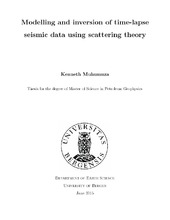| dc.description.abstract | Waveform inversion methods can be used to obtain high-resolution images of the elastic and acoustic property changes of petroleum reservoirs under production, but remains computationally challenging. Efficient approximations in modelling the wavefield based on scattering approaches are desirable for solving time-lapse inversion problems and to test the settings in which they give accurate predictions. In this thesis, we are concerned with acoustic waveform modelling and inversion in frequency domain with emphasis on first- order scattering methods. Key themes of review and discussion include the derivation of scattering problems using Green's function techniques; Born approximation, distorted-Born approximation, Distorted Born iterative T-matrix method (DBIT); and the concepts of seismic waveform inversion and its application to different approaches in time- lapse seismic imaging. We employ the Born approximation and distorted-Born to simulate time-lapse synthetic seismograms and test the settings in which these methods are valid by benchmarking them against the exact T-matrix approach. The new distorted-Born approximation presented considers a general heterogeneous reference medium and provides a framework for imaging of regions of time-lapse variation using the baseline survey as a reference and the monitor survey as perturbed to directly estimate the perturbation. This poses a linear inverse scattering problem for which suitable linear and non-linear inversion methods are applicable. Synthetic testing based on different 2D models demonstrate that the new distorted-Born approximation provides accurate predictions of the difference data seismograms, at least in the settings considered while the Born approximation is limited to applications involving small volume and velocity contrasts. The inversion results show that Born inversion (in its limits) and DBIT method sufficiently retrieves the time-lapse velocity changes even in the cases of relatively low signal to noise ratio. Inversion of the difference data (differential approach) not only gives improved results but also proves to be useful and efficient since a single inversion procedure is performed for a pair of seismic experiments and hence computationally less expensive. The DBIT method which considers a dynamic background media and a variational T-matrix approach may be very useful in seismic characterisation of petroleum reservoirs under production and may be more efficient in monitoring of CO2 sequestration. | en_US |
